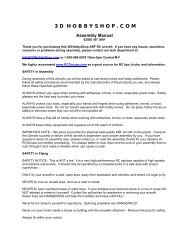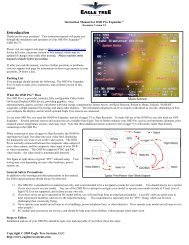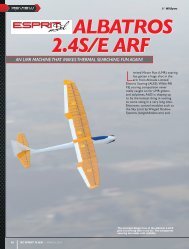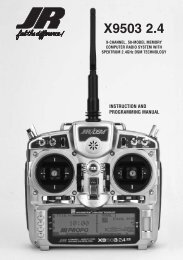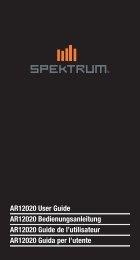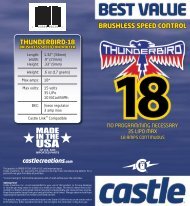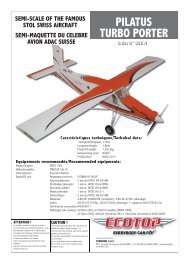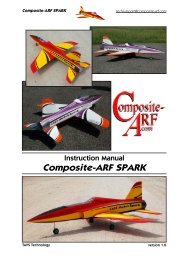DeNight Special 50 Manual - CMC Versand
DeNight Special 50 Manual - CMC Versand
DeNight Special 50 Manual - CMC Versand
You also want an ePaper? Increase the reach of your titles
YUMPU automatically turns print PDFs into web optimized ePapers that Google loves.
Academy of Model Aeronautics<br />
National Model Aircraft Safety Code<br />
Effective January 1, 2010<br />
GENERAL<br />
A model aircraft shall be defined as a non-humancarrying<br />
aircraft capable of sustained flight in the<br />
atmosphere. It may not exceed limitations<br />
established in this code and is intended to be used<br />
exclusively for sport, recreation, and/or competition.<br />
1. I will not willfully fly my model aircraft in a careless<br />
or reckless manner, and will abide by this Safety Code<br />
and any additional rules specific to flying sites.<br />
2. I will yield the right-of-way to man-carrying aircraft<br />
and will see and avoid all aircraft, utilizing a spotter<br />
when appropriate. (See AMA Document #540-D on<br />
See and Avoid Guidance.)<br />
3. I will not fly my model aircraft higher than<br />
approximately 400 feet above ground level, when<br />
within three (3) miles of an airport without notifying the<br />
airport operator.<br />
4. The maximum takeoff weight of a model aircraft,<br />
including fuel, is 55 pounds, except for those flown<br />
under the AMA Experimental Aircraft Rules.<br />
5. I will not fly my model aircraft in sanctioned events,<br />
air shows, or model demonstrations unless I have<br />
previously proven that my aircraft, control<br />
system, and piloting skills are adequate by<br />
successfully executing all maneuvers intended or<br />
anticipated in the specific event. If I am not a<br />
proficient pilot, I will not fly in these events unless<br />
assisted by an experienced pilot.<br />
6. I will not fly my model aircraft unless it is identified<br />
with my name and address, or AMA number, inside or<br />
affixed to the outside of the model aircraft. This<br />
does not apply to model aircraft flown indoors.<br />
7. I will not operate model aircraft with metal-blade<br />
propellers.<br />
8. I will not operate model aircraft carrying pyrotechnic<br />
devices which explode or burn, or any device, which<br />
propels a projectile of any kind. Exceptions include<br />
Free Flight fuses or devices that burn producing<br />
smoke and are securely attached to the model aircraft<br />
during flight. Rocket motors up to a G-series size may<br />
be used, provided they remain firmly attached to the<br />
model aircraft during flight. Model rockets may be<br />
flown in accordance with the National Model Rocketry<br />
Safety Code; however, they may not be launched<br />
from model aircraft. Officially designated AMA Air<br />
Show Teams (AST) are authorized to use devices and<br />
practices as defined within the Team AMA Program<br />
Document.<br />
9. I will not operate my model aircraft while under the<br />
influence of alcohol or while using any drug which<br />
could adversely affect my ability to safely control the<br />
model.<br />
10. When and where required by rule, helmets must<br />
be properly worn and fastened. They must be OSHA,<br />
DOT, ANSI, SNELL or NOCSAE approved or comply<br />
with comparable standards.<br />
RADIO CONTROL<br />
1. All pilots shall avoid flying models over unprotected<br />
people.<br />
2. I will complete a successful radio equipment<br />
ground-range check in accordance with the<br />
manufacturer’s recommendations before the first flight<br />
of a new or repaired aircraft.<br />
3. At all flying sites a safety line or lines must be<br />
established, in front of which all flying takes place.<br />
Only personnel associated with flying the model<br />
aircraft are allowed at or in front of the safety line. In<br />
the case of air shows or demonstrations a straight<br />
safety line must be established. An area away from<br />
the safety line must be maintained for spectators.<br />
Intentional flying behind the safety line is prohibited.<br />
(See AMA Document #706 for Recommended Field<br />
Layout.)<br />
4. I will operate my model aircraft using only radiocontrol<br />
frequencies currently allowed by the Federal<br />
Communications Commission (FCC). Only individuals<br />
properly licensed by the FCC are authorized to<br />
operate equipment on Amateur Band frequencies.<br />
5. I will not knowingly operate my model aircraft within<br />
three (3) miles of any preexisting flying site without<br />
a frequency-management agreement. (See AMA<br />
Document #922 for Testing for RF Interference. See<br />
AMA Document #923 for Frequency Management<br />
Agreement.)<br />
6. With the exception of events flown under official<br />
AMA Competition Regulations rules, excluding takeoff<br />
and landing, no powered model may be flown<br />
outdoors closer than 25 feet to any individual, except<br />
for the pilot and the pilot’s helper(s) located at the<br />
flight line.<br />
7. Under no circumstances may a pilot or other person<br />
touch a model aircraft in flight while it is still under<br />
power, except to divert it from striking an individual.<br />
This does not apply to model aircraft flown indoors.<br />
8. Radio-controlled night flying requires a lighting<br />
system that provides the pilot with a clear view of the<br />
model’s attitude and orientation at all times.<br />
9. The operator of a radio-controlled model aircraft<br />
shall control it during the entire flight, maintaining<br />
visual contact without enhancement other than by<br />
corrective lenses that are prescribed for the pilot.<br />
First-Person View (FPV) flying may only be conducted<br />
in accordance with the procedures outlined in AMA<br />
Document #5<strong>50</strong>.<br />
48 <strong>DeNight</strong> <strong>Special</strong> <strong>50</strong> ARF Assembly <strong>Manual</strong>


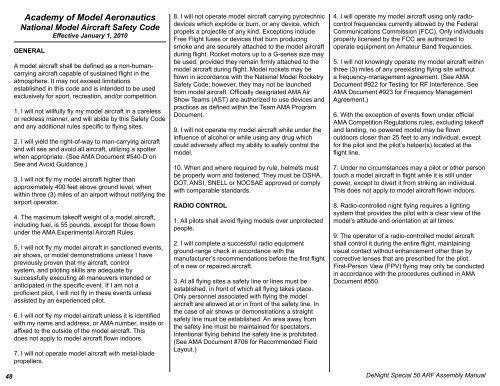
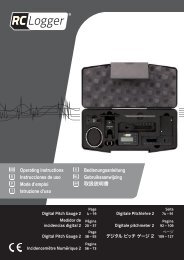
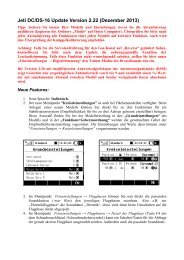

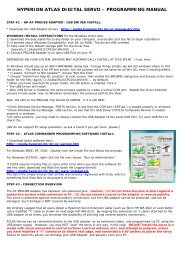
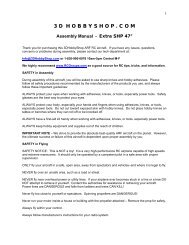
![P01(Oxalys EP) [更新済み].ai - Kyosho](https://img.yumpu.com/26948574/1/184x260/p01oxalys-ep-ai-kyosho.jpg?quality=85)
